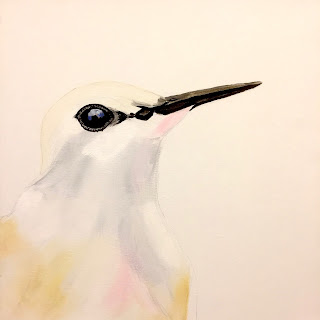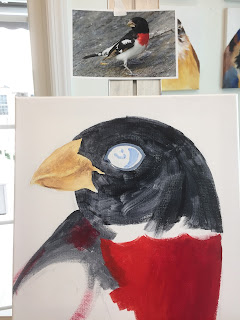Thursday, December 15, 2016
A Little Hummingbird is Added to the Bird Portraits - well almost added!
Developing a painting from an idea, photo, or real life requires some fore-thought and planning. Aside from the obvious color choices, the composition is probably the primary concern, followed by the balance of dark/light, positive/negative space, and so much more. One reason why I chose to do simple bird portraits was because I could eliminate many of the typical concerns of an artist as they approach their subject and simply focus on the primary portrait of a particular bird.
As you probably can guess from my writings, I have been a bird lover and watcher since childhood, when my grandfather was kind enough to point out different birds as they landed in his garden or sang from his apple tree. He gave my my first bird books, The Little Blue Bird Book and The Little Yellow Bird Book. I still have the blue one some 60 years later - although I couldn't locate it if I tried!
As this little female Ruby Throated Hummingbird is coming out on the canvas, I find her subtle shadings much more complex than I had realized they would be. Isn't it strange how we can be so familiar with something and still not know it in detail? That's another reason why I've chosen to do bird portraiture. I want to be more observant to all the subtleties as well as the obvious traits of my little feathered friends.
Adding the beak and eye certainly brings the bird more to life than the subtle shadings of her breast! The beak is several different shades of gray, not all of which are yet captured.
Making the eye really look like a living bird's eye has much to do with creating the roundness of the eyeball via shading and with the wonderful highlights or reflections in the eye itself. Some birds have brown, black, green, blue, even yellow eyes. So it's important to notice precisely with eye color belongs to the bird on the easel! And creating the reflections - that is really what makes the eyes dance and come alive for me.
And it's a process, a deepening of color here; a lightening up of tone there. Every stroke counts - so noticing just what goes where and whether or not you want the bristles of the brush to show through the paint or not, these all impact the finished piece of art.
My little hummer is not yet complete. As Christmas approaches, my studio time is somewhat more limited. That and a myriad of appointments on the calendar. I will continue posting both the Red-Bellied Woodpecker and the Female Ruby-Throated Hummingbird as then move towards completion.
Monday, December 12, 2016
Painting Process for a Red-Bellied Woodpecker
I begin with a light pencil drawing directly on the canvas. I lay in a few colors, just to get a feel for the bird, the colors, the mood, and as a simple place to start.
Colors are added in layers - hoping to achieve the wide variety of feathers as they are affected by their colors and the lighting. Starting with the darker colors allows me to place lighter colors on the surface, overlapping the darker colors, as would occur in life.
It's time to add some detail so that I can better relate with the bird I'm working on. Adding the highlights in the eye and beginning to add some color to the beak, both of which enliven the woodpecker for me.
I work on gallery-wrapped canvas - and this requires that I paint around the edges in case the buyer does not wish to frame the completed piece. The woodpecker is on a young tree, so that required painting the top, middle, and bottom edges to some degree.
Or course, the bird itself must also be painted around the bottom edge of the canvas. I turn the painting on it's side so that the paint will dry without sticking to my easel and then running the risk of losing some paint to the easel!
It's time to add the bright reds - which really set this bird apart from others (as do the black and white wings, added later). Generally speaking, the colors are pretty intense when added - they can be easily muted and toned down or up to the proper degree as work progresses.
Here some of those reds are, indeed toned down a bit, giving more of a feathery appearance than just paint brush lines! Also, some lighter areas are added to the breast area as depth and dimension are beginning to appear.
Also, the eye is being developed at this stage, which helps me better related to the bird and create harmony between the feathers and the areas that stand out like the beak, the eyes, and the bright red on the back of his head.
More muting of the reds, softening of the feathered strokes.
Now it's time to begin detailing the wings, which I've totally ignored until this point. Looking at it tonight, I realize that the wing on the left side by the tree seems to protrude too much away from the bird's body. It also appears to be too high on that side, making the bird look off balance, to say the least.
That's work for tomorrow. It's always good to have time to get away from a work in progress so that when coming back to it, the awkward parts stick out, the colors that don't work appear off key, and it's time to rework whatever needs to be done to create a solid piece of art work.
And a bonus photo! The porch is just outside my studio door and I can hear when the flocks of birds arrive. At this time of year, our year-round Bluebirds come for meal worms and a variety of finches come for thistle seed.
It snowed last night, so the birds were on our porch this morning for food. Here is a Bluebird with a dried meal worm in his beak taken from the feeder.
Colors are added in layers - hoping to achieve the wide variety of feathers as they are affected by their colors and the lighting. Starting with the darker colors allows me to place lighter colors on the surface, overlapping the darker colors, as would occur in life.
It's time to add some detail so that I can better relate with the bird I'm working on. Adding the highlights in the eye and beginning to add some color to the beak, both of which enliven the woodpecker for me.
I work on gallery-wrapped canvas - and this requires that I paint around the edges in case the buyer does not wish to frame the completed piece. The woodpecker is on a young tree, so that required painting the top, middle, and bottom edges to some degree.
Or course, the bird itself must also be painted around the bottom edge of the canvas. I turn the painting on it's side so that the paint will dry without sticking to my easel and then running the risk of losing some paint to the easel!
It's time to add the bright reds - which really set this bird apart from others (as do the black and white wings, added later). Generally speaking, the colors are pretty intense when added - they can be easily muted and toned down or up to the proper degree as work progresses.
Here some of those reds are, indeed toned down a bit, giving more of a feathery appearance than just paint brush lines! Also, some lighter areas are added to the breast area as depth and dimension are beginning to appear.
Also, the eye is being developed at this stage, which helps me better related to the bird and create harmony between the feathers and the areas that stand out like the beak, the eyes, and the bright red on the back of his head.
More muting of the reds, softening of the feathered strokes.
Now it's time to begin detailing the wings, which I've totally ignored until this point. Looking at it tonight, I realize that the wing on the left side by the tree seems to protrude too much away from the bird's body. It also appears to be too high on that side, making the bird look off balance, to say the least.
That's work for tomorrow. It's always good to have time to get away from a work in progress so that when coming back to it, the awkward parts stick out, the colors that don't work appear off key, and it's time to rework whatever needs to be done to create a solid piece of art work.
And a bonus photo! The porch is just outside my studio door and I can hear when the flocks of birds arrive. At this time of year, our year-round Bluebirds come for meal worms and a variety of finches come for thistle seed.
It snowed last night, so the birds were on our porch this morning for food. Here is a Bluebird with a dried meal worm in his beak taken from the feeder.
Sunday, December 11, 2016
Having Fun with Black Canvas & Cows!
Holstein Portrait #1 - (c)Pat Dolan Acrylic Painting 9"x12"
Below, a few photos of the process of painting these wonderful animals. I used white chalk pencil on the black canvas to draw the important shapes to indicate the particulars of each cow.
Holstein Cow #2
Early stages of Holstein #2
And the completed pair:
Holstein #1 and #2 - (c)Pat Dolan Acrylic Portrait Paintings - 9"x12"
Still Painting Bird Portraits...
Above is my very first acrylic bird portrait, an American Eagle done on my Native American drum back in the 1990's.
Below are the step-by-step photos of two recent paintings in process. I didn't think to take very many photos - once I start painting, I'm in another world and time zone!
Completed: Carolina Wren & Rose-Breasted Grosbeak - (c)Pat Dolan - 12" x 12" acrylic
Below are the step-by-step photos of two recent paintings in process. I didn't think to take very many photos - once I start painting, I'm in another world and time zone!
Completed: Carolina Wren & Rose-Breasted Grosbeak - (c)Pat Dolan - 12" x 12" acrylic
Subscribe to:
Posts (Atom)































